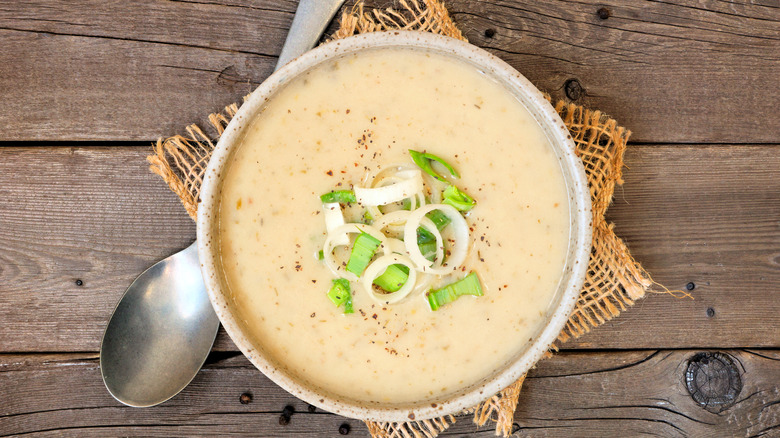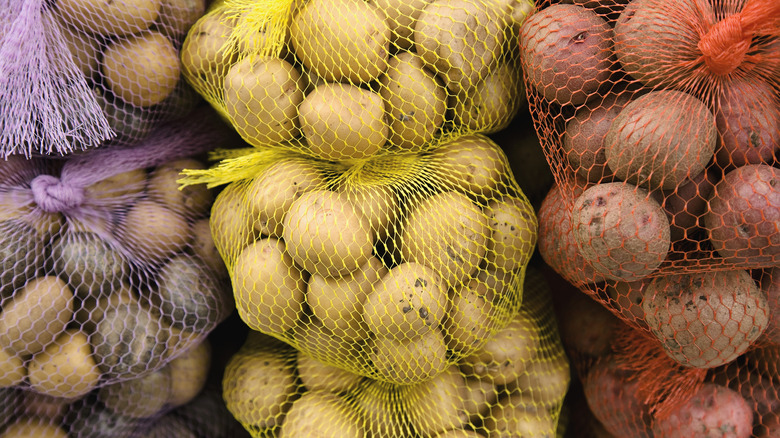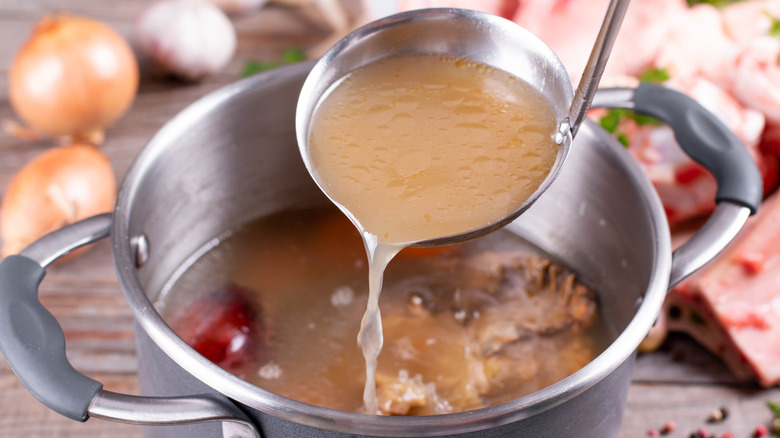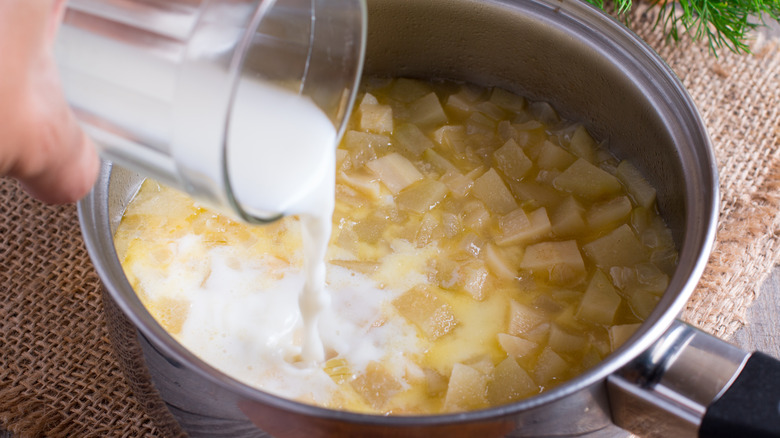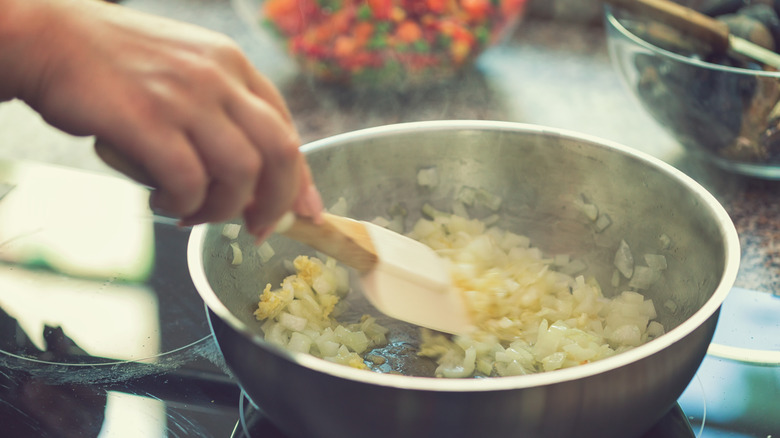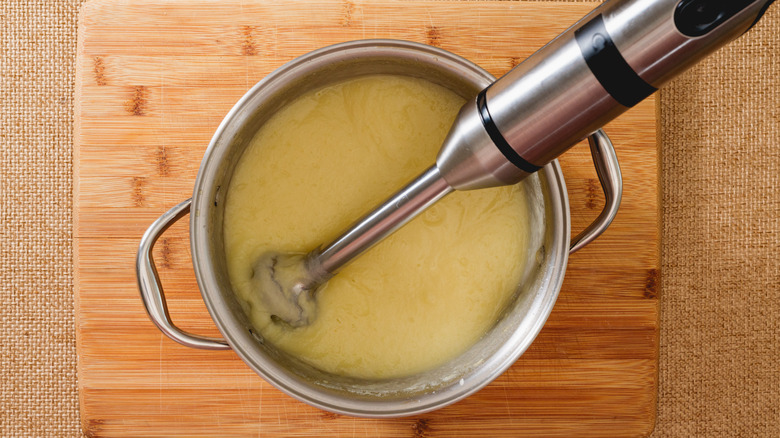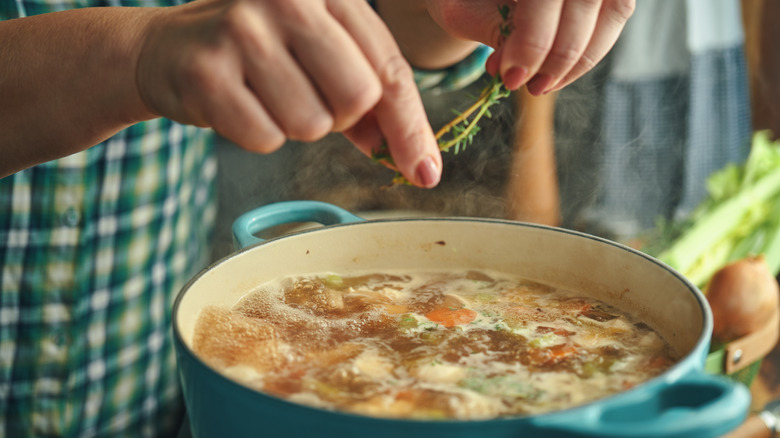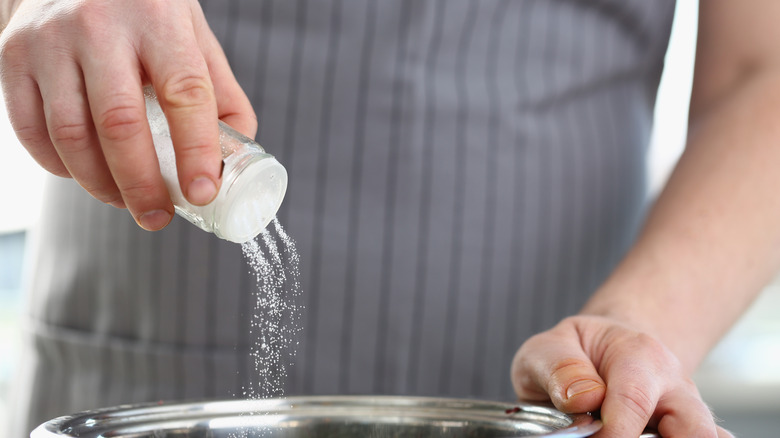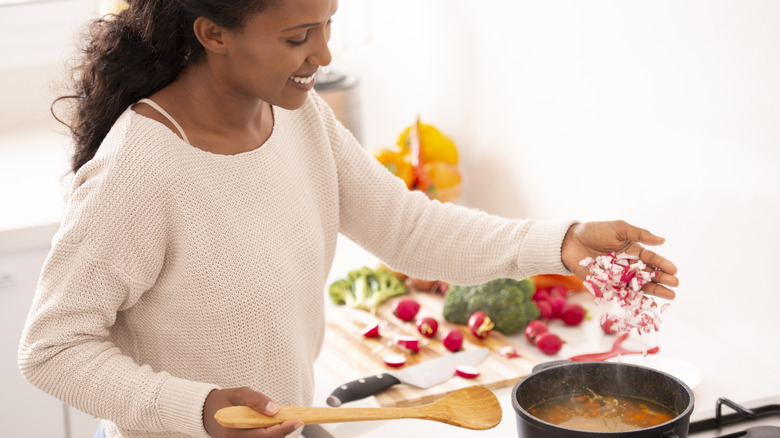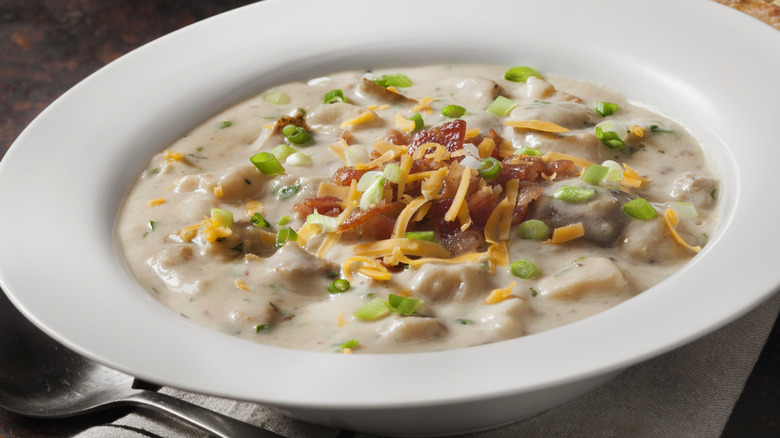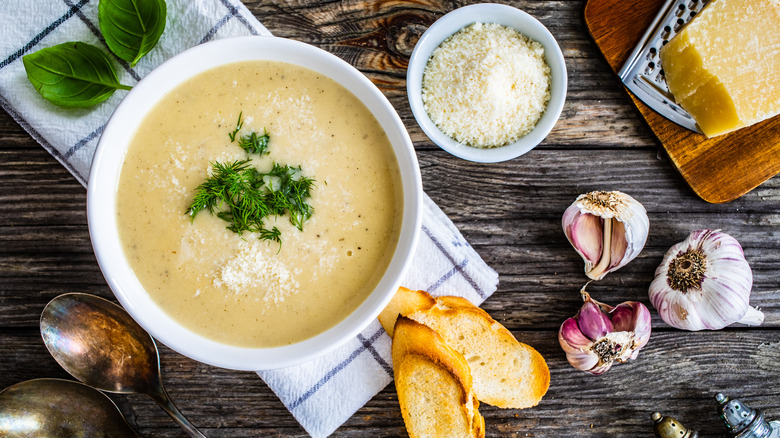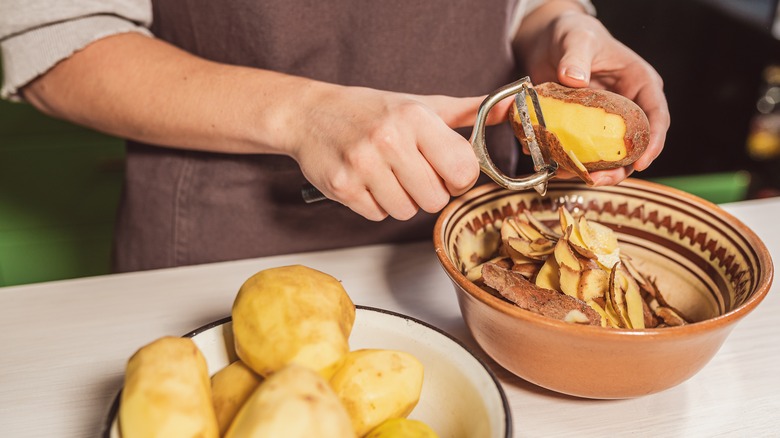12 Mistakes Everyone Makes With Potato Soup
Potato soup is a humble dish with a rich, earthy flavor and a hearty, rustic nature. Prepared with a satisfyingly simple combination of ingredients, it's the kind of soup that can warm you up on the chilliest of days while at the same time, eliciting a feeling of comfort that only home cooking can truly offer.
Cooking potato soup may seem simple, but inexperienced cooks often make common mistakes that can result in a bland or unpleasantly textured soup. To avoid these issues, it helps to know what to watch out for and to know how to make necessary adjustments throughout the cooking process.
In this article, we'll explore some of the most common blunders people make when preparing potato soup and offer some practical tips and advice on how to avoid them. Put them into practice, and you're sure to be crafting the perfect potato-based soups in no time.
1. Using the wrong type of potatoes
Potatoes are such a common food that they may seem all the same to most people. Yet there are actually more than 200 types of potatoes found throughout the world. They can vary in terms of their textures, flavors, and culinary uses. So, it's no surprise that choosing the right potato for your soup can be confusing. Fortunately, potatoes fall into one of three categories. They're either starchy, waxy or somewhere in between.
When making a creamy potato soup, you want to use a starchy potato that will easily break down during cooking and result in a smooth and creamy texture. Russet potatoes, Idaho potatoes, and Yukon Golds are all ideal for creamy soups as they have a light, tender texture. These potatoes have a high starch and low moisture content, which means they absorb liquids and flavors well and will create a smooth and tasty soup.
On the other hand, if you're looking to make a chunky potato soup, you'll want to choose a waxy potato that will hold up throughout cooking. Red potatoes, new potatoes, and fingerling potatoes are all good choices as they tend to retain their shape well. These kinds of potatoes have low starch and high moisture content, which means they have a solid texture that can withstand a boiling pot of soup.
2. Not using quality stock or broth
Potato soup is a straightforward dish that doesn't require a complicated cooking method or a long list of components. That's why using high-quality ingredients, including the liquid you add to your soup, is significant.
You can always use water in your soup, but if you want it to have a full body and dimension, a good stock or broth can make all the difference. They have the ability to transform a bland soup into a flavorful meal, as well as adding extra nutritional value.
If you're wondering about the difference between chicken stock and broth, either will make an excellent base for a potato soup. Broths are made by simmering meat with vegetables and other flavorings, while stocks are made by simmering the bones. Of course, for a vegetarian potato soup, vegetable broth works just as well in contributing a rich and flavorful foundation.
While shopping for stock and broth, be sure to check the details on the package. Avoid ones with preservatives or a long list of ingredients. You'll also want to pay attention to the sodium and select one with less salt when possible. That way, you can salt your soup to the level you prefer. Alternatively, making your own stock or broth will allow you to completely control the sodium level, quality, and flavor.
3. Using the wrong type of dairy
Dairy can certainly enhance the creaminess and flavor of a pureed potato soup. However, choosing the right type of dairy is necessary to complement the soup's taste and consistency.
Cream is a good place to start, and there are various types of cream to choose from, each with its unique properties. Heavy cream is the richest and highest fat option, ideal for those who desire a decadent, creamy texture. On the other hand, if you prefer a lighter soup, half-and-half or even milk would make excellent additions. Or add sour cream or even yogurt if you like a tangy flavor in your potato soup. Either can be stirred into the soup or used as a topping.
Of course, it's crucial to consider dietary preferences while adding dairy to your soup. Many non-dairy alternatives can contribute similar creamy results to your potato soup if needed.
4. Adding dairy too early
Whether using milk, cream, or another type of dairy, doing so can add that extra richness and silkiness that make a soup feel luxurious. Unless that is, you add them to the pot too early in the cooking process.
If added too early, you may find that the dairy curdles and creates an unpleasantly lumpy and unattractive soup. That's because high heat, like that of a boiling soup, can cause the proteins and milk in dairy to separate.
To prevent milk or cream from curdling in soup, the key is to add it to the end of the cooking process. The soup should otherwise be fully cooked, and the dairy should be one of the last ingredients stirred into the pot. It's a good idea to keep your soup at a low simmer — or even off the heat altogether — when you add the dairy to the pot. That way, it can gently meld into the soup.
5. Skipping the sautéing of aromatics
When cooking, especially soups, it's helpful to layer the flavors. This doesn't mean physically stacking ingredients but rather cooking them in stages and using different methods to create a depth of flavor in the final dish. It's generally best to add ingredients gradually instead of all at once, especially in soups, stews, and sauces. By layering flavors, you create a more complex and satisfying dish.
One of the most crucial stages of layering flavors is the process of sautéing your aromatic ingredients. These are items such as onions, garlic, celery, carrots, ginger, peppers, woody herbs, and dry spices. When these kinds of ingredients are sautéed in fat during the early stages of cooking potato soup, you're creating a strong foundation of flavor. In fact, sautéing leeks as your aromatic ingredient is a great way to elevate creamy potato soup, and it's why potato leek soup remains a classic.
6. Forgetting to blend or mash the potatoes properly
Achieving a smooth and silky texture is key to a creamy potato soup. To accomplish this, you need to sufficiently blend or mash your potatoes. There are a few ways to go about this process and potatoes are just one of many veggies for blending into pureed soups.
The easiest way to blend vegetables like potatoes into a soup is to use an immersion blender. This works well because you can stick the blender directly into the pot of soup. Just remove the soup from the heat before blending, and keep the blender completely submerged in order to avoid splattering hot liquid around your kitchen.
However, if you only have a stand blender, that will work just as well with a little more effort. You'll want to let the soup cool slightly before transferring it to the blender, and make sure to keep your blender slightly vented to allow steam to escape. Unless you have an extra large blender, you will have to do this process in batches.
And if you don't have any kind of blender yet still want a creamy result, the next best option is to mash the potatoes with a potato masher once they're tender. You will likely have to mash a few times to help them fully break down into the soup.
7. Not flavoring the soup adequately
There are many ways to flavor a soup. Aside from sautéing your aromatics and using a quality broth or stock, there are numerous other ways to upgrade homemade potato soup, and it's often a matter of utilizing a few different strategies.
Perhaps the simplest approach is to flavor your soup with salt throughout the cooking process. Instead of waiting until the end of cooking to realize your soup lacks taste, you can add a bit of salt during each phase of cooking. Doing so will help bring out the flavors of each of the ingredients.
Another good strategy is using a deglazing liquid between sautéing the aromatics and adding liquid to the pot to start the simmering phase. Wine, cider, beer, or juice may be used, and each adds its own flavor while also helping to release the tasty brown bits from the bottom of the pan.
Adding an acid like vinegar or lemon juice and incorporating fresh herbs can also help add flavor to a potato soup. While you may not need to implement all of these strategies, it's good to keep them in the back of your mind for when you realize your next pot of soup needs a flavor boost.
8. Overseasoning
It's crucial to avoid overseasoning potato soup while at the same time ensuring it has enough flavor. Too many flavors or too much of any one seasoning can quickly overpower the soup and overwhelm the taste buds.
Oversalting is a common mistake of home cooks, and potato soup is no exception. You may think that potato soup requires extra salt because we tend to oversalt other potato foods like French fries and potato chips. But you have to keep in mind the flavor of all of the ingredients that go into the soup, including the saltiness of your stock or broth.
If you find that you added too much salt and are wondering how to fix an oversalted soup, there's an easy answer: add potatoes. Potatoes help absorb excess salt, so adding them is the answer to nearly any oversalted soup. In this case, since the base of a potato soup is already made up of potatoes, adding some more to the pot will provide a seamless solution for the extra salt. You may need to add water if the soup becomes too thick.
9. Not making adjustments as it cooks
Few dishes are as forgiving as soup. That's why it's essential to make adjustments as you go. One of the best ways to do this is by tasting your potato soup as it cooks. By doing this, you can avoid serving a soup that lacks flavor or doesn't have the right consistency. Don't wait until it's too late to make adjustments; keep testing and adjusting your soup until it's just the way you want it.
Although you certainly want to taste soup as you cook, there's a reason you shouldn't taste soup right after adding spices or other flavorings. You need to give them a little time to fully incorporate into the soup before making adjustments. If you add salt, spices, herbs, acid, or any other seasoning to modify the soup, it is best to wait a few minutes before tasting it again and deciding if any additional adjustments are required.
10. Leaving off a complimentary garnish
A topping or garnish can elevate the flavor and texture of potato soup and take it to the next level. From fragrant herbs to crunchy bacon bits, the possibilities are endless. Don't overlook the importance of a garnish — it can make all the difference in transforming a simple soup into something extraordinary.
There are many ways to garnish your soup. A chunky potato soup can be garnished with dollops of sour cream, sprinkled with shredded cheese, and topped with crispy crumbled bacon just as you would a baked potato. On the other hand, a creamy potato soup can be elevated with the addition of crunchy croutons and a sprinkle of fragrant herbs such as parsley, chives, or dill. These toppings enhance the taste while also adding visual appeal.
You don't need to go overboard, however. Even the most basic garnishes, such as a glug of olive oil, crushed crackers, or a spoonful of creamy yogurt, can make a big difference.
11. Failing to let the flavors develop
Potato soup can develop an excellent flavor without cooking it all day. Yet, it's important not to rush it either. If you find that your potato soup is lacking in taste, the easiest solution may be just to let it continue cooking.
In the best soup recipes, you'll discover that there are always stages of cooking that allow the flavors to develop. This starts by sautéing the aromatics to enhance their flavor and continues with each step, including a simmering period for the soup. This is true in even the speediest of recipes.
Nevertheless, if you're in a hurry and still crave the taste of a fully developed soup, an electric pressure cooker might be the solution. You can find a potato soup recipe specifically designed for a pressure cooker or modify your existing recipe with some practice. The high pressure in these cookers shortens the cooking time while still allowing the flavors to develop fully.
12. Not peeling the potatoes
If you want to achieve the creamiest and smoothest texture in a pureed potato soup, you have to peel your potatoes. Failing to do so can lead to an unpleasant, gritty texture that could ruin the soup. Potato peels can also darken the color of your soup, making it less visually appealing. However, if you're making chunky potato soup, you can feel free to leave the peels on as long as you scrub them thoroughly to remove any dirt.
If the thought of having to peel potatoes induces dread, there are a number of potato-peeling hacks to try. Rather than picking up the peeler with each stroke on the potato, use a back-and-forth motion instead. This will speed things up and save you time and energy. Another tip is to check and see if your potato peeler has an eye remover, also known as a potato eyer. It looks like a small scoop at the end of the peeler, which you use to pop out any sprouts.
